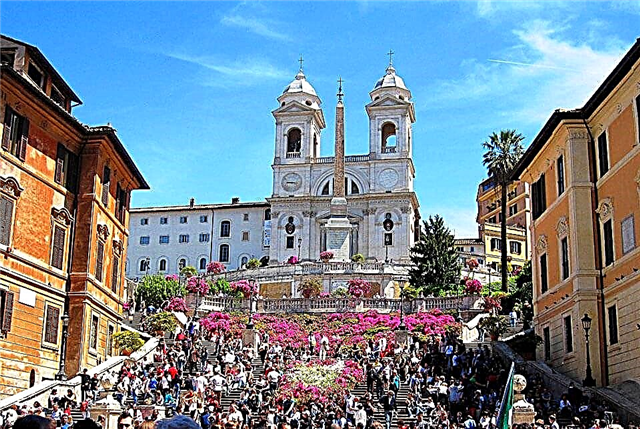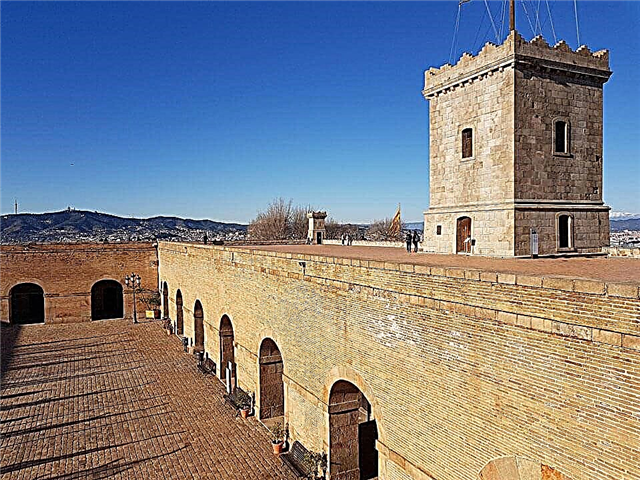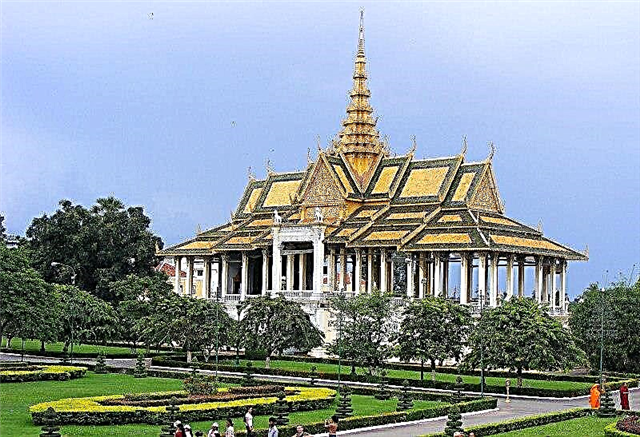Address: France, city of Avignon
Architect: Pierre Poisson
Number of towers: 12
Main attractions: Dressing Room, Kitchen Towers and Tower of Angels, Dad Chair
Coordinates: 43 ° 57′2.88 ″ N, 4 ° 48′27 ″ E
Content:
Short description
One of the most magnificent architectural structures in the entire Old World, the Papal Palace is located in the small French city of Avignon. Its long and interesting history, external façade and beautiful surrounding landscapes have made this UNESCO World Heritage Site one of the most visited places in France.

A bird's eye view of the Papal Palace
Every year millions of tourists from all over the world come to look at the huge fortified walls and giant towers. By the way, the city of Avignon itself, with a population of just under 90,000 inhabitants, is a kind of open-air museum. It even has its own Notre Dame (though not "de Paris", but de Avignon), three beautiful churches made by architects in the Gothic style and the Calvet Museum, which is popular among visitors to the city.
However, in this material we will talk about the most beautiful and most the main attraction of Avignon - the Papal Palace, a place that was previously called nothing else than the "Avignon Captivity of the Popes".
Running a little ahead, I would like to immediately note that Avignon is not associated with any terrible captivity or a prison like the Chateau d'If. Simply "Avignon captivity of popes" is a forced stay of the heads of the Catholic Church in France. By the way, they lived in this country comfortably and, one might even say, on a special scale. True, this can already be attributed to the history of the Papal Palace, which should definitely be dwelt on, because it is thanks to her that the architectural masterpiece is so popular.

View of the Papal Palace from Palais
A huge number of tourists with cameras can be found already on the approaches to the Palais des Papes, because it is the photographs of the facade of the place of the Avignon Captivity of the Popes that are simply wildly popular. If you look at any of them, it may seem that the picture captures not a palace, fortress or castle, but the whole huge France. a medieval city, from which a whole army of crusaders is about to leave, setting off on another campaign in the name of the true faith.
There is nothing surprising in the size of the residence, the heads of the Catholic Church have always lived in huge palaces: the reason, of course, was not the claustrophobia of the popes, but the need for a large number of rooms where the main shrines of the Christian world could be kept.
For example, the modern Vatican, where the Pope lives and raises his prayers to God, is not just a palace, but a whole state within a state. Therefore, there is nothing supernatural in the fact that such a gigantic palace was rebuilt in the French city of Avignon. After all, it was in this palace that the popes received monarchs and archbishops, by and large, from a small French city, the main priests of the Catholic Church ruled not only numerous parishes, but also influenced the fate of entire states.

Entrance to the Papal Palace
Papal Palace in Avignon - the story of the "capture of the popes"
The popes' temporary refuge, as mentioned above, was the French city of Avignon. This small settlement was completely bought out by the Catholic Church in 1348.
Although the first pope, forced to flee Rome, where war was literally declared against the Catholic priests, settled in Avignon back in 1309. The first Pope, who transferred the curia to France from "sinful" Rome, was a native of Gascony Bertrand de Got. After lengthy meetings of Catholic clergy, he was named Pope Clement V. Seeing that his predecessors are being killed in Rome, he decides to go to Avignon and from there bless all the parishioners. It is from this period of time that it is customary to count the beginning of the "Avignon captivity of the popes", which lasted, by the way, until 1378. Not many tourists who come to France to get acquainted with its sights know that the Pope lived and performed divine services on the territory of this country for more than three centuries.

General view of the Papal Palace from the Rhone River
Construction of the Papal Palace in Avignon
Pope Clement V, who came to Avignon from Rome, settled initially in a modest cell of the Dominican monastery. Only his successor, Pope John XXII, realized that in France the top clergy would have to stay for a long time, and in Avignon it was necessary to build a palace that would fully correspond to the influence and power of the popes. Alas, John XXII did not manage to live up to the start of the grandiose construction, or, to be very precise, until the beginning of the reconstruction of the old episcopal palace in Avignon.
The first work on the construction of a giant papal palace began only under Benedict XII in 1364.... As you can see from the above, at that time the popes could do everything in Avignon without exception: from 1348 the whole city belonged to the Catholic Church. There is some mention in historical documents that the city was not acquired, but received by the Catholics as a gift from the King of France, but most of the chronicles say that Avignon was bought. Most likely, the acquisition of the whole city cost the Catholic Church a symbolic amount. All the secrets associated with the "Capture of the Popes in Avignon" are currently safely stored in the Vatican. Naturally, none of the clergy with access to the archives and treasury of the Vatican is not going to shed light on the financing and acquisition of various lands by the church, including the purchase of Avignon in 1348.

From left to right: Notre Dame de Dôme Cathedral, Bell Tower
As can be seen from official documents, Pope Benedict XII did nothing but offer prayers to God and ask him to atone for sins for the Romans. He disdained luxury, which did not prevent him from building a palace in the northern part of Avignon, which historians call the "Old". The word "palace" is not quite suitable for the first structure, which was erected on a high rock and which was surrounded by impregnable walls and a moat. It would be extremely difficult for a hostile army to penetrate there. Simply put, Pope Benedict XII, who still remembered the barbarity and atrocities of the Romans, decided to safely hide in a powerful fortification. The plan of the huge fortress was developed and the work was supervised by the architect Pierre Poisson.
After Pope Benedict XII, the construction of the palace continued: new loopholes appeared in the “old palace”, and the walls were strengthened. In addition, under the successors of John XXII and Benedict XII, the "New Palace" was erected. Even the most zealous Catholic did not dare to speak about any asceticism, which all popes, without exception, had to adhere to. Two palaces, the construction of which took colossal sums, donated mostly by parishioners, occupied an area exceeding 11,000 (!) Square meters.

View of the western facade of the palace
Many contemporaries of the "Avignon Captivity of Popes" in their notes said that the whims of the clergy were too expensive for all Catholics, not only in France, but also in Europe.
The construction of the New Palace, which was no longer distinguished by asceticism, lasted during the reign of three popes: Clemente VI, Innocent VI and Urbana V. These zealous Catholics, "thinking only of God", commissioned Jean de Louvre to expand the palaces and build a huge number of office premises.One of these premises is the incredibly expensive chapel called "Bolshaya". Its height was 52 meters, and its interior decoration could shock even the kings of France. According to the popes, it was impossible to do without such a chapel, because it was in it that they offered their prayers to God. In addition to the Great Chapel, the palace acquired two magnificent towers and a huge courtyard, which the popes decided to call the "Courtyard of Honor". This name was supposed to show all parishioners that their popes are in forced exile, but they remember what a duty to the flock is, and that they are honest before the people.

View of the Bell Tower from the courtyard
Papal Palace in Avignon - "dear captivity"
Naturally, a simple man in the street who lived during the "papal captivity" could not get into the palace... Therefore, only people close to the popes knew about the majestic sculptures, expensive paintings, tapestries, stucco and gold decoration of the interior of the Papal Palace in Avignon. The well-known humanist Petrarch at that time sharply condemned such a desire of the popes in exile for luxury and repeatedly expressed fears that in the near future the popes would gain uncontrolled power over France and a number of other European countries.
During their forced captivity in Avignon, the popes completely changed a number of Catholic rites. By the way, they even decided that archbishops and abbots should not have been elected by monks and other clergymen by voting. In Avignon, people began to be appointed as abbots and archbishops only by order of the pope. Thanks to this state of affairs, the papal treasury grew every year. The power of the top of the Catholic Church, even over the monarchs, was no longer in doubt. In 1378, the popes were finally able to return from their "exhausting" exile to Rome. There, thanks to the huge treasury, they could no longer be afraid of assassination attempts or outrage from the crowd. Probably, it was from that period of time that the power and almost unlimited power over many countries of the world, which the Pope and the Vatican state possess, appeared. After the popes left their palace in Avignon, it gradually began to decline. Only in 1417, the pope lived there, who was excommunicated and who subsequently fled to Spain.

Courtyard of Honor of the Papal Palace
Papal Palace in Avignon - a unique monument of history and architecture
Nowadays, tourists who visit the papal palace in Avignon often ask guides why the impregnable fortification is called a "palace". Impenetrable walls, towers with loopholes, a huge moat and practically empty premises are all that remains of the former greatness. And yet it is a palace, if only because it went down in history thanks to its luxurious interior decoration and the power of the popes. The thing is that during the French Revolution, all the hatred of the impoverished French poured out on many magnificent palaces, castles and residences. The papal palace did not escape complete plunder and even partial destruction.
At the moment, the palace is under the protection of UNESCO, but the rich interior decoration has not been restored during the numerous reconstructions of this landmark. During the excursion, the traveler is invited to inspect the many rooms and 12 towers, each of which bears its own name. Two of them are the most interesting, and cause in suspicious people a feeling of ever-increasing horror. These are the towers called "Toilet" and "Kitchen". In the "Toilet Tower" during the French Revolution, wealthy Frenchmen were deprived of their lives with enviable regularity. The revolutionaries did not particularly stand on ceremony with the bodies: they were thrown from a height into a huge pit. No one was going to bury the decaying corpses, so the stench spread several kilometers from the papal palace. "Kitchen Tower" got its name not because culinary masterpieces were prepared in it. There are legends that during the Inquisition, heretics were slowly roasted on a huge spit.

Fragment of the western facade of the palace
In addition to these two terrible towers, you can also see the premises in which the popes lived, alas, nothing remained of the former luxury in them. Only the Great Chapel is able to evoke a sense of reverence for the higher powers thanks to the unique and miraculously preserved rich ceiling painting. A visit to the "Tower of Angels", where the dads' bedroom was located, will also make an unforgettable impression. Everything in it looks poor and meager, by the way, as in the refectory, but according to some architectural elements and preserved painting, any historian will immediately say that these rooms in ancient times were decorated with extremely rich and, one might even say, pretentious. A reminder of the former splendor of this tower is the wall paintings, most of which were painted over by vandals during the French Revolution. It reproduces a vine and birds sitting on it with unique accuracy. By the way, songbirds have always been highly valued by “dads in exile”, probably for this reason, their images are often found in the paintings made by Sienese artists.
For a tourist who goes independently, and not as part of one of the excursion groups, to the papal palace in Avignon, the best solution would be to purchase a special guidebook. It is quite easy to get lost in a huge building, as mentioned above, the majestic fortress-palace spreads over an area of 11,000 square meters.

Courtyard of the Old Palace
In the papal palace, you can see in the cathedral a beautiful chair of the popes, made of expensive white marble and some of the pieces of furniture made of precious wood. and dating from the 15th century. Alas, these are almost all the exhibits that can be seen today in the papal palace of Avignon. However, it attracts attention not by its interior decoration, but by its unique architecture and gloomy Gothic style. In addition, tens of thousands of tourists come to the legendary Avignon Theater Festival, which has been held since 1947. The best theater groups in the world give performances there. No decorations are needed, the Palais des Papes in Avignon perfectly replaces them. The performances take place in the famous courtyard, called by the popes the “Courtyard of Honor”.











